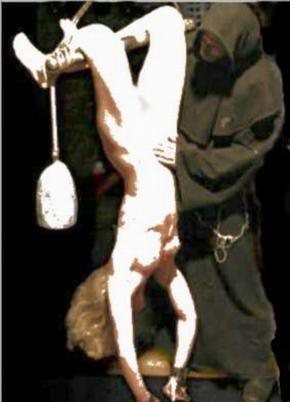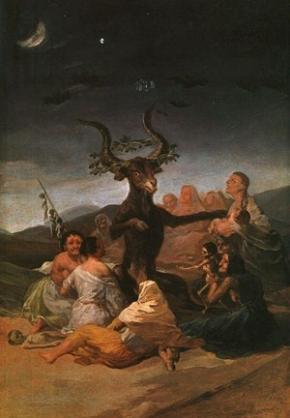The moral economy of witchcraft: an essay in comparative history - I
1In a recent study of slave trading, the Beninois historian Felix Iroko (1988: 199) notes with some embarrassment an oral tradition about the provenance of cowry shells, a major currency in this commerce. According to indigenous informants, cowries were obtained by killing slaves, floating their bodies in the Atlantic Ocean, and pulling them back after cowries had adhered to the corpses.2
 Such local knowledge not only clashes with our empirical information on the origin of cowry shells— Iroko reminds us that they were imported to West Africa from the Indian Ocean via Europe— but also contradicts the entire body of analysis built around recent economic studies of the slave trade. Precisely by focusing on a commodity like cowries these studies have argued for the relevance of market principles in understanding African development. First of all, it can be demonstrated that the movements of cowries and slaves across a complex international market operated according to predictable patterns of supply and demand; secondly, in the interior of West Africa large-scale imports of shell currency allowed the monetization (and thus market expansion) of transactions in foodstuffs and other local consumer items (Hogendorn and Johnson, 1986).
Such local knowledge not only clashes with our empirical information on the origin of cowry shells— Iroko reminds us that they were imported to West Africa from the Indian Ocean via Europe— but also contradicts the entire body of analysis built around recent economic studies of the slave trade. Precisely by focusing on a commodity like cowries these studies have argued for the relevance of market principles in understanding African development. First of all, it can be demonstrated that the movements of cowries and slaves across a complex international market operated according to predictable patterns of supply and demand; secondly, in the interior of West Africa large-scale imports of shell currency allowed the monetization (and thus market expansion) of transactions in foodstuffs and other local consumer items (Hogendorn and Johnson, 1986).
The equation of cowries with slave corpses derives from a very different view of what such commerce meant both within Africa and in African relations with the wider world. It does not take much imagination to understand why death should be the metaphor for a traffic built upon the removal of human beings from their home continent, many to a literal death but virtually all to “a bourn from which no traveller returns.” The more challenging task is to consider how fully the perception embodied in such terms represents an alternative to the concept of market rationality and its encompassing discourse of modernization.
This task will be pursued here through the discussion of two well established ideas in academic literature: moral economy and witchcraft. The first is a pure abstraction purporting to explain the response to capitalism of various communities who, like Africans in the slave trade era and afterwards, insist that considerations other than those of the market should and do govern the production and distribution of material goods. The middle portion of this essay will review critically the debate over moral economy to consider how useful it may be for understanding African history.
 Witchcraft, as used here, is also an abstraction, but one intended to represent directly the terms used by African and other societies to describe their own beliefs and practices. The introductory section of the essay will attempt to identify an African witchcraft idiom which gives broader meaning to texts such as the Beninois oral account of slave-cowry transactions. The concluding section will examine the early-modern European “witch craze” in order to consider how the elaboration of common elements in European and African culture both reflects and mediates differing trajectories into the modern world.
Witchcraft, as used here, is also an abstraction, but one intended to represent directly the terms used by African and other societies to describe their own beliefs and practices. The introductory section of the essay will attempt to identify an African witchcraft idiom which gives broader meaning to texts such as the Beninois oral account of slave-cowry transactions. The concluding section will examine the early-modern European “witch craze” in order to consider how the elaboration of common elements in European and African culture both reflects and mediates differing trajectories into the modern world.
African Witchcraft Idiom as a Discourse of History and Power.
The various issues surrounding witchcraft, including the comparison of African and European cases, have long been a staple of Africanist anthropological research.3 All these discussions share a general definition of witchcraft as the use of preternatural power by one person to damage others; almost all have focused on beliefs about such practices and the means used to counter them rather than on the practices themselves; all assume that beliefs of this kind have important social consequences and reflect the manner in which the peoples concerned understand their broader historical experience.
For purposes of the present analysis two issues in African witchcraft studies are to be emphasized: (i) the kinds of social relationships involved in witchcraft accusations; and (ii) the role of reproduction, sexuality and gender in these beliefs.
Virtually all existing work, at least in rural Africa, indicates that witchcraft efficacy is held to be a direct function of the intimacy between witch and victim. Thus the vast majority of accusations and rituals involve relations between peers, kin and co-wives; the corollary being that, with greater social distance, such accusations would decline (Douglas, 1970, xxx f.; Marwick, 1980: 377 ff.). Recent research, however, shows African urban elites to be afraid that those left behind in their villages are bewitching either them or the state projects with which they identify (Geschiere 1988, Ciekawy 1990, Bastian, infra). Also, while formal witchcraft accusations against the powerful and wealthy are rare, it has “become a commonplace observation in African studies” (Rowlands and Warnier 1988: 121) that such ascendent individuals are perceived to be witches.
Commonplace as it may be, the equation of witchcraft with the attainment of power and wealth has been neglected in the anthropological literature, which has mainly focused on the sociology of formal witchcraft accusations. However it is witchcraft beliefs which cross hierarchical boundaries that enter most directly into the concerns of the present essay: the contemplation of historical change by Africans; the competition of witchcraft idioms with the discourses of markets and modernization; and their comparison with early modern European anti-witchcraft beliefs.4
For this purpose van Binsbergen (1981: 141-42) provides a very useful distinction between “impersonal” and “anti-personal” witchcraft. The latter consists of misfortunes attributed to the ill will of peers with whom some identifiable tension already exists. It is this category which Marwick (1970: 330) probably had in mind when he asserted that “increased tensions attendant upon urbanization are not necessarily expressed in the idiom of witchcraft.” Impersonal witchcraft, on the other hand is defined by van Binsbergen (1981: 163) in terms all too easily linked to modern situations as “the reckless manipulation of human material for strictly individual purposes.”
In rural African the human material manipulated by witchcraft is frequently identified with control over the forces constituting the reproduction of everyday life. In the most unproblematic circumstances, these forces are contained within the domestic sphere of conjugal sexuality and food cultivation and consumption. Congenital witches are almost always described as insatiably hungry: they seek to “eat” others by imbibing their reproductive powers in the form of corpses, children, sexual fluids, and so on.
 A number of studies (Goody 1970, Gottlieb, 1989) have noted a distinction between female witches, who are totally stigmatized, and males who are recognized as both witches and legitimate figures of political and ritual authority. The distinctions do not lie in the activities or immediate relationships to reproduction and production which identify each category as witches: all may be guilty of killing and consuming close relatives and the males may procure wealth only by predation upon surrounding societies. Rather it is the public positions held by the men in question which makes their witchcraft somehow more tolerable and even, in some cases, celebrated. This acceptance of “official” witchcraft is generally explained as a form of resignation: anti-witchcraft measures are ineffective against such concentrations of power (Rowlands and Warnier 1988: 121). But it is also recognized that many Africans take the existence of witchcraft to be inevitable and ubiquitous; there is thus positive value in the fact that some figures of authority have the mystical power to ward off the malignancy of others. This need is particularly strong when the dangers come from outside the community and can only be combatted by kings and diviners of one’s own. (Goody 1970, Austen 1986).
A number of studies (Goody 1970, Gottlieb, 1989) have noted a distinction between female witches, who are totally stigmatized, and males who are recognized as both witches and legitimate figures of political and ritual authority. The distinctions do not lie in the activities or immediate relationships to reproduction and production which identify each category as witches: all may be guilty of killing and consuming close relatives and the males may procure wealth only by predation upon surrounding societies. Rather it is the public positions held by the men in question which makes their witchcraft somehow more tolerable and even, in some cases, celebrated. This acceptance of “official” witchcraft is generally explained as a form of resignation: anti-witchcraft measures are ineffective against such concentrations of power (Rowlands and Warnier 1988: 121). But it is also recognized that many Africans take the existence of witchcraft to be inevitable and ubiquitous; there is thus positive value in the fact that some figures of authority have the mystical power to ward off the malignancy of others. This need is particularly strong when the dangers come from outside the community and can only be combatted by kings and diviners of one’s own. (Goody 1970, Austen 1986).
The conception of witchcraft as an ambiguous attribute of power within Africa is often presented in ahistorical terms, as a timeless reflection of the tension between communal values and selfish individualism and anxieties about natural threats to subsistence. However, our data on witch beliefs are all relatively recent; with little exception they are drawn from societies which had long been involved with either the Islamic or European outside world. It is striking that several West Central African cosmologies link witchcraft with the deployment of victims in a nocturnal and/or distant “second universe,” echoing, in a more or less explicit terms, the experience of the Atlantic slave trade (Hagenburcher-Sacripanti 1973: 143-63, de Rosny 1985: 58-63; McGaffey 1986, Miller 1988: 4-5).
The Beninois explanation of cowry imports should now appear more familiar, not only as a metaphorical account of the slave trade but also as the expression of a discourse equating the acquisition of wealth and power with (i) the consumption of human life and (ii) links to a more powerful outside world. But, if we are to assert the relevance of this discourse for understanding the wider African experience of historical change, we need to consider it in more general terms. The witchcraft idiom in Africa echoes perceptions elsewhere in the world of relationships between communal norms and externally-centered market economies. The comparison of these perceptions and relationships by social scientists has produced its own meta-discourse around the concept of moral economy.
(…)
- 1. John Comaroff and Peter Geschiere provided very helpful comments on earlier versions of this essay.
- 2. Following the initial presentation of this essay, colleagues have reported similar traditions from various parts of the West African coast.
- 3. see the essays in this collection [Comaroff and Comaroff, eds. Modernity and its Malcontents] by Apter, Auslander, Bastian, Masquelier, Schmoll. For older accounts, see Douglas 1970, Marwick, 1970, 1982. for more recent ones, Rowlands and Warnier, 1988; Geschiere, 1988
- 4. for a comparison of African and European witchcraft concepts which stresses the distinction between “primitive” and “complex” societies on the basis of what sort of malevolent behavior individuals actually confessed to, see Rowland, 1990.